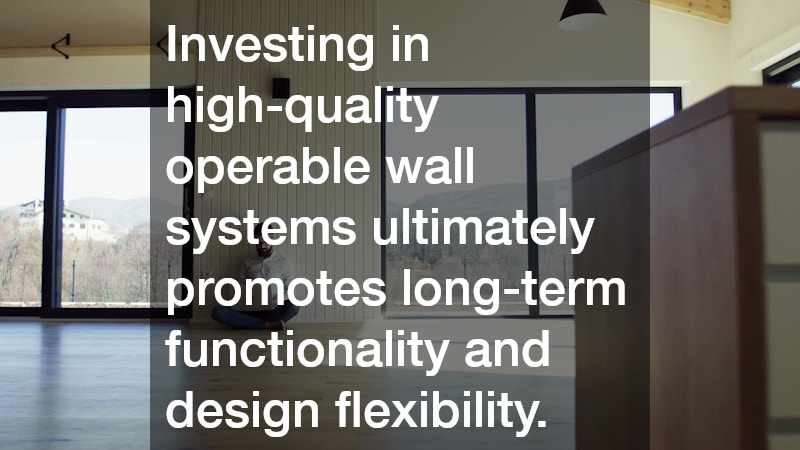In today’s dynamic environments, the need for adaptable spaces has never been higher. Operable wall solutions provide the flexibility required in modern offices, schools, and event venues. This article explores operable wall options, their benefits, and considerations for implementing them effectively.
1. What Are the Benefits of Using Operable Wall Solutions?
1.1 Enhanced Space Flexibility
Operable walls allow spaces to be reconfigured quickly to accommodate different activities and group sizes, from compact work areas to large event spaces. This adaptability maximizes the use of available space, allowing multiple functions to occur harmoniously within a single environment.
The ability to partition spaces dynamically helps in optimizing room layouts for various events and meetings. By installing operable walls, organizations can transition seamlessly between open-plan layouts and segmented workspaces, promoting both collaboration and concentration.
Particularly in urban settings where real estate is at a premium, operable walls offer a cost-effective solution to meet fluctuating spatial demands. These systems enable the same square footage to serve multiple roles, reducing the necessity for additional permanent constructions.
1.2 Acoustic and Aesthetic Advantages
Modern operable wall systems offer excellent soundproofing properties while also enhancing the interior design with a range of materials and finishes. Such acoustic benefits ensure that activities in adjacent spaces do not interfere with one another, maintaining productivity.
The aesthetic flexibility of operable walls allows them to integrate seamlessly into existing architectural designs. Designers can choose from a variety of finishes, colors, and textures, ensuring that the wall systems complement the overall decor.
Acoustic performance is further enhanced by incorporating sound-absorbing materials and advanced sealing technologies. This makes operable walls ideal for environments where privacy and quietness are paramount, such as schools and corporate offices.
2. How Do Operable Walls Work?
2.1 Mechanisms and Technologies
Explore the various mechanisms such as manual and automated systems, along with cutting-edge technologies that make operable walls easy to use. Automated systems often incorporate motorized controls, enabling effortless reconfiguration at the push of a button.
Manual operable walls, on the other hand, offer cost-effective simplicity while still providing robust operational efficacy. These systems might require a bit of physical effort but are often equipped with smooth gliding tracks that facilitate easy movement.
Technological advancements have also led to the development of walls with touchscreen interfaces and remote operation capabilities. This innovation further enhances user convenience and ensures that the operable walls can be adjusted quickly as per the specific requirements of a given scenario.
2.2 Installation and Maintenance
An overview of the installation process, maintenance requirements, and best practices for keeping operable walls functioning smoothly over time. A successful installation involves precise measurements and professional handling to guarantee efficacy and longevity.
Regular maintenance, such as lubricating moving parts and checking alignment, extends the life of operable wall systems. It’s essential to follow manufacturer recommendations and schedules to preserve the system’s functionality.
In the long run, well-maintained operable walls contribute significantly to operational efficiency, reducing downtime and repair costs. Proper care not only ensures longevity but also maintains the aesthetic and acoustic properties, making them a worthwhile investment.
3. What Should Be Considered When Choosing Operable Wall Systems?
3.1 Cost and Budget Considerations
Discuss the budgeting aspects, including upfront costs versus long-term savings, which are crucial when considering operable wall solutions. Initial expenses can be offset by the enhanced functionality and reduced need for additional space.
Organizations should consider total cost of ownership, which includes periodic maintenance and potential energy savings. By reducing the necessity for artificial lighting and air conditioning when areas are not in use, operable walls contribute to energy efficiency.
An economically mindful approach should balance the upfront costs with anticipated returns, both monetary and functional. Decision-makers are encouraged to evaluate these versatile installations as strategic investments rather than mere expenses.
3.2 Customization and Design Options
Details about the options available for tailoring operable wall solutions to meet specific functional and aesthetic needs of a space. Customization can include varying heights, integrations with other building facilities, and even incorporated technology.
The ability to design operable walls that sync with organizational branding or thematic interior design is an attractive feature for many. Such adaptability ensures that each unit not only serves its purpose but also visually enhances the environment.
The perfect operable wall solution aligns with both the practical and stylistic objectives of a space. By understanding and utilizing the plethora of options available, stakeholders can optimize the operable walls to suit their unique setting.
Operable wall solutions are a valuable investment for creating flexible spaces that meet various needs. By understanding their benefits, functioning, and key considerations, businesses and organizations can optimize environments for multiple uses, enhancing productivity and user satisfaction. With options available for soundproofing, custom finishes, and smooth operation, these walls offer practical, adaptable, and aesthetically pleasing solutions for modern interior design challenges. Whether for educational institutions, corporate offices, or hospitality venues, operable walls enable seamless transitions between open and divided spaces, supporting evolving space requirements without permanent structural changes. Investing in high-quality operable wall systems ultimately promotes long-term functionality and design flexibility.



